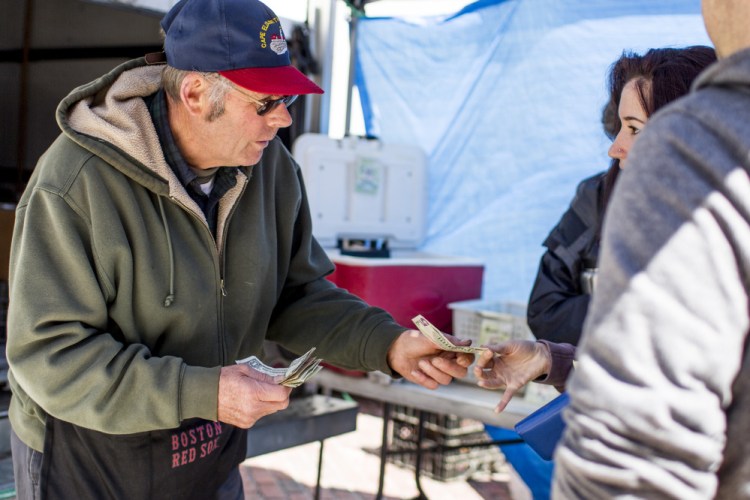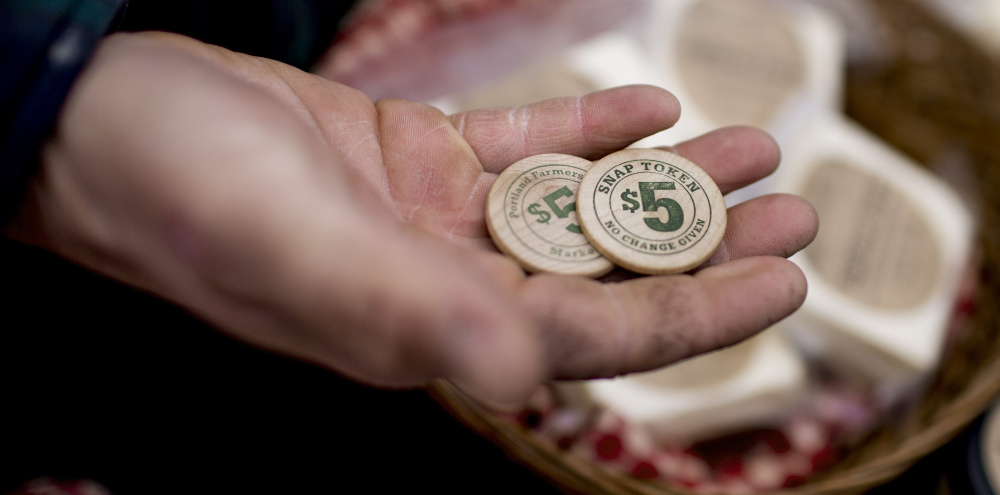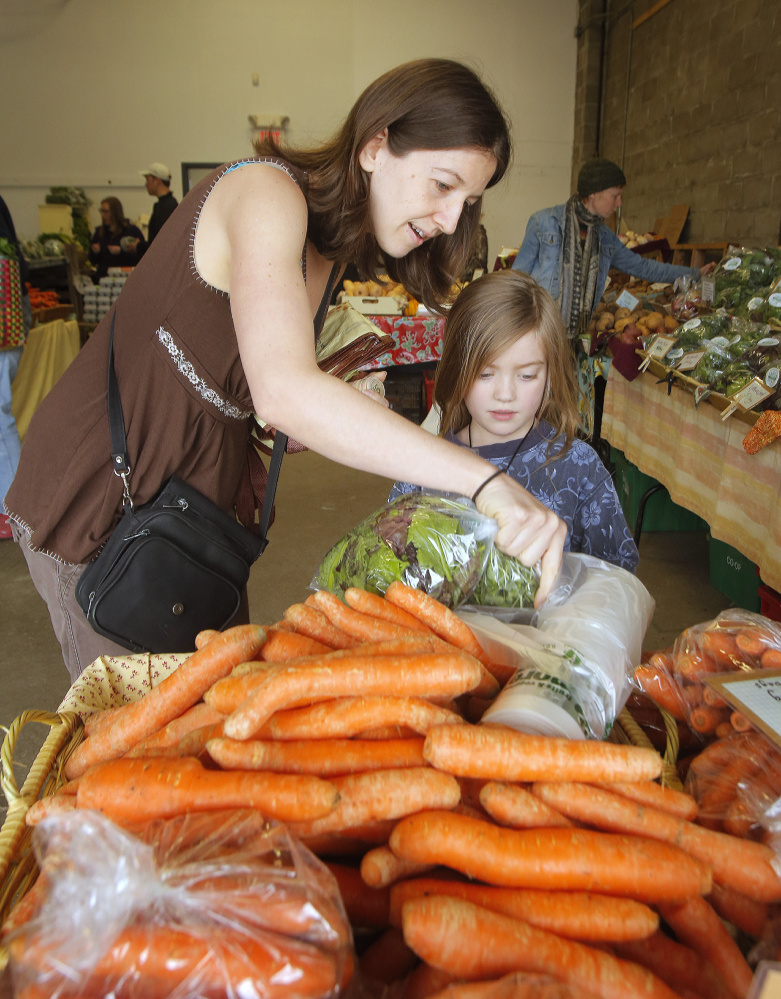Jennifer Lehto plunked down her electronic benefit transfer card Saturday at the Portland Farmers Market and received a stack of wooden tokens back to buy locally produced food for her family.
The Yarmouth resident said being able to use her food stamp card at the market makes a big difference in her family’s life. Her son, Niko Wilson-Lehto, 4, requires a diet high in fat and low in sugar, the only regimen that helps control his epilepsy. The only place she can readily find sugar-free bacon and high fat whipping cream is at farmers markets.
For every $2 she spends at Portland Farmers Market, she receives an additional $1 worth of fruits and vegetables, thanks to the market’s Low Income Access Program, which has been working since 2011 to make the market available to recipients such as Lehto of the federal Supplemental Nutrition Assistance Program – or SNAP – as food stamps are formally known.
So the $80 Lehto spent on her EBT card Saturday gave her an additional bonus of $40 in produce, which really stretches out her food budget as a single mother and graduate student working to become a nurse practitioner.
“I wouldn’t be able to pay the prices the local farmers have to charge for their hard work,” said Lehto.
SNAP TO ATTENTION
The use of federally funded food stamps at Maine farm stands has exploded over the past five years as agencies and programs worked to improve access to fresh produce from local farmers.
Purchases at Maine farmers markets using food stamps jumped 860 percent during that period, according to new data provided by the U.S. Department of Agriculture.
In 2010, Mainers redeemed a total of $12,560 in SNAP benefits at farmers markets. That number jumped to $120,549 by 2015. The increase is the largest among New England states and is seen as positive news for both low-income Mainers and for Maine farmers.
“We love to see people utilizing farmers markets with the SNAP card because they’re purchasing locally grown, less processed, healthier foods. For the local farmers, these dollars are going back into the Maine economy. It’s a plus both ways,” said Kevin Concannon, a Maine native who now serves as the USDA’s undersecretary for food, nutrition and consumer services. “Maine has a really vibrant group of local organizations that are promoting farmers markets.”
The increase has coincided with outreach efforts and improved access for SNAP recipients using state-issued EBT cards. The number of Maine farmers markets that allow customers to use EBT cards rose from 13 in 2010 to 50 last year, according to the USDA.
The spending still represents a small fraction of overall SNAP benefits provided to Mainers with low incomes. Mainers received $321 million in SNAP benefits in fiscal year 2014, the most recent data available from the USDA.
About 200,000 Mainers – or nearly one in seven – receive SNAP benefits each month.
Public health advocates and buy-local supporters nationwide have worked to improve access to fresh foods, which can be out of reach to low-income families because of the expense and because farm markets have been inaccessible to customers with EBT cards. Maine is among the states that have seen the most dramatic gains in access to the locally grown foods.
Low-income Mainers said they appreciate being able to buy farm-fresh food.
“We don’t spend our money frivolously and the quality of the food is great,” said Elly Lovin of Portland, who was buying groceries Saturday at the Portland market, accompanied by her husband, Jesse Bania, and their 10½-month-old son, Asa Lovin.
Leigh Hallett, executive director of the Maine Federation of Farmers Markets, said incentive programs that give SNAP recipients bonus dollars are bringing more shoppers to farmers markets.
Despite the USDA figure of 50 Maine farmers markets accepting EBT cards in 2015, Hallett said she expects 36 farmers markets – or 30 percent of all farmers markets in Maine – to accept the cards this year and to offer Maine Harvest Bucks, which are federally funded with matching local contributions. That program will infuse more than $90,000 into the local economy this year, she said.
Through the Maine Harvest Bucks program, shoppers receive a bonus for fruits and vegetables for every $1 they spend on foods at farmers markets. In Maine, SNAP recipients receive an average of $28 per person per week.
“These incentives for bonus fruits and vegetables allow (shoppers) to stretch those dollars further,” Hallett said.
The Maine Federation of Farmers Markets recently launched a new website, maineharvestbucks.org, to help shoppers find out which farmers markets accept SNAP. The organization’s website also has a searchable database of all farmers markets in the state.
Clara Moore, manager of the Portland Farmers Market Low Income Access Program, said the market is the busiest in the state in the number of food stamp users who shop there.
The Portland Farmers Market features a booth where EBT and credit card users alike use their cards to purchase the wooden tokens, which can be used just like cash at the market.
While the market was doing a brisk business with EBT users Saturday at the market’s winter quarters at 80 Cove St., more EBT shoppers will show up when the market moves to its warm weather-locations at Monument Square on Wednesdays starting Wednesday and Deering Oaks starting Saturday, Moore predicted.
BENEFITS FOR ALL
The push to get Mainers to use their SNAP benefits at farmers markets is popular with farmers, who see benefits for both themselves and the customers.
“One of the great benefits is it keeps the money in the state of Maine. When they shop at the market, they’re supporting local farmers,” said Doug Donahue of Balfour Farm in Pittsfield.
Donahue travels to farmers markets across the state to sell organic cheese, yogurt and eggs. Most of the markets he goes to – including Bangor, Portland and Brunswick – accept EBT cards, but this year he and his wife will receive their own card reader so they can accept SNAP at markets that don’t have kiosks set up to accept EBT cards.
Donahue said he tends to see the most SNAP purchases at the Bangor Farmers Market and is hopeful he sees similar results in Orono once he has a card reader. That market does not accept EBT cards, he said. Donahue said it’s hard to estimate how much of his sales are paid for with SNAP money because it varies so much week to week.
“You can tell when EBT benefits come out because the following week we’ll have a big week,” he said.
Last week, Donahue explained how to use SNAP to shopper Kara Lyons of Portland, who was interested in buying cheese from his stand, which was set up in Monument Square. She told him she’d be back when the outdoor market officially opens for the season and becomes accessible to SNAP benefits.
“It’s awesome. I want to support local food and I like all natural stuff,” Lyons said.
Jodie Jordan of Alewive’s Brook Farm in Cape Elizabeth said he would like to see every farmers market he attends accept EBT cards. He sees the option as a good one for both customers and farmers.
“It’s healthier for them and it helps us out,” he said.
Jack McAdam of the Sanford Farmers Market said it started accepting EBT cards in late 2010 after going to a farmers market convention and hearing people talk about the idea. “I started realizing that there were people out there with food stamps and it could bring more money into the market,” he said.
Last year, SNAP redemptions brought in almost $9,000 to the Sanford Farmers Market, which is held twice weekly. McAdam said the market has built up a regular base of shoppers using SNAP, but organizers are still trying to figure out how to draw in more people to use their SNAP money there. Each year, between 70 and 80 people who shop at the market using SNAP only come once during the season.
“We like to have them be repeat customers,” he said.
The Sanford market, which opens for the season April 30, has started putting up posters advertising the market and its participation in the Maine Harvest Bucks program around the city, including in the local Department of Health and Human Services office.
Hallett, of the farmers market federation, said she is excited to see the number of markets accepting SNAP continue to grow, especially because it is a big commitment on behalf of the market organizers, volunteers and farmers to set it up.
“There’s a tremendous amount of enthusiasm,” she said. “As they see more people in their community access local food, it tends to make people even more energized about the market.”
Send questions/comments to the editors.







Comments are no longer available on this story